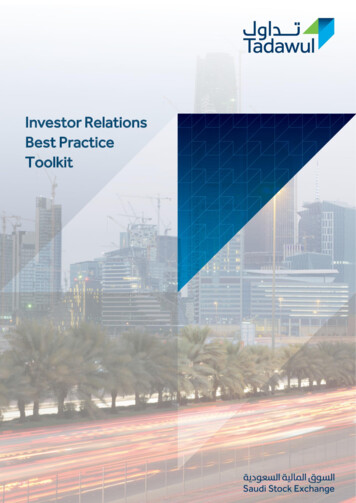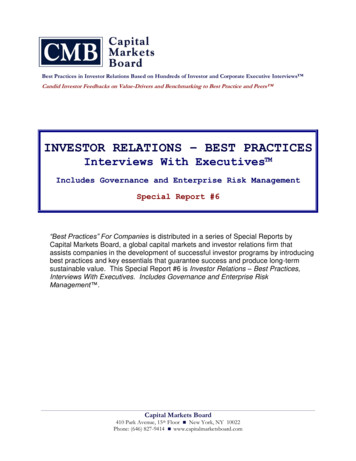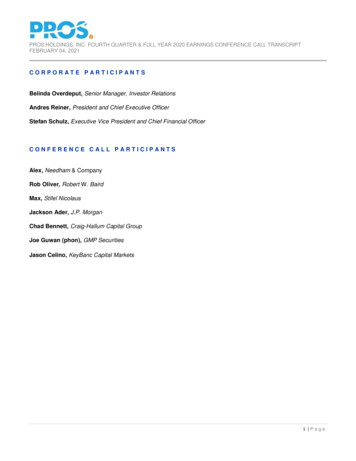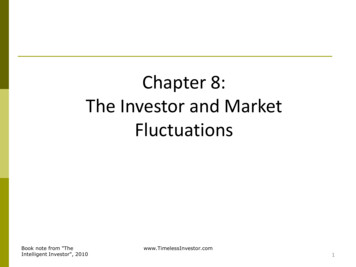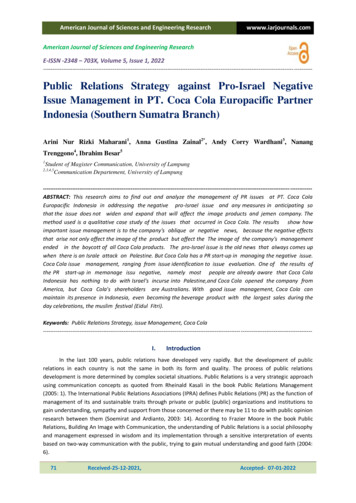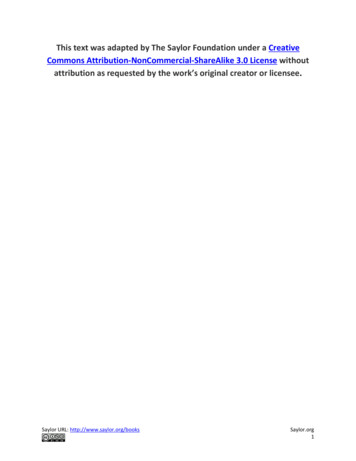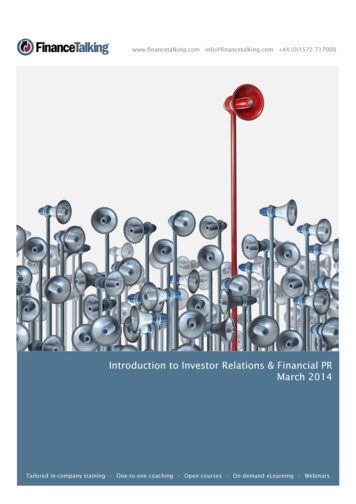
Transcription
www.financetalking.com info@financetalking.com 44 (0)1572 717000Introduction to Investor Relations & Financial PRMarch 2014Tailored in-company training One-to-one coaching Open courses On-demand eLearning Webinars
About FinanceTalkingAbout FinanceTalkingFinanceTalking was founded in 2000 by Miranda Lane with a view to providing the bestfinancially orientated training to the corporate communications world. We design and teachhighly relevant, practical courses for both our open access training program and for companiesin-house.Our assignments range from graduate training programs through to helping large in-housemedia relations, investor relations and internal communications departments and IR trainingfor new board directors.Our clients range from multinationals listed on a number of stock exchanges globally, to smallcaps and companies intending to list. We are headquartered in the UK, but teach regularly inthe USA, Middle East and continental Europe. We also have tutors based in Australia, CIScountries and South Africa.Our course materials are designed to appeal to all learning styles. We use color-coded visuals,hands on games, quizzes and role play to ensure that learning can be transferred successfullyto the work place.To find out more, call us or go to www.financetalking.com. FinanceTalking Ltd2www.financetalking.com
ContentsContents1 Introduction . 42 Rationale for IR & Financial PR . 52.1 Regulatory Requirement .52.2 Preserving a Ready Market for New Capital .52.3 Ensuring the Share Price Reflects Fair Value .52.4 Enhancing Corporate Reputation .63 Capital Markets Overview – the Context . 73.1 Companies .73.2 Investment Banks .83.3 Sell-Side Analysts .83.4 Investors and their Portfolio Managers .83.5 Buy-Side Analysts .93.6 Retail Investors .93.7 Corporate Governance .93.8 Regulators .103.9 Financial Media .104 Financial Communications In-House . 114.1 Organisation of Communications Functions .114.2 Typical Reporting Lines .125 Key5.15.25.3Target Audiences for Financial PR and IR . 14Investors and their Buy-Side Analysts .14Sell-Side Analysts .14Financial Media .156 The6.16.26.36.4Web of Communications . 16Buy-Side Communications .16Sell-Side Communications .17Sell-Side Research Notes .17Media Relations .177 Typical IR Activities . 187.1 Shareholder identification and analysis: .187.2 News releases and presentations .187.3 Meetings with investors .197.4 Annual report, website etc .197.5 Analyst identification .197.6 Presentations and meetings for analysts .197.7 Responding to queries .197.8 Managing expectations .198 Typical Financial PR Activities . 208.1 Messaging and reputation .208.2 Managing relationships with the media .208.3 News releases and media presentations .208.4 Crisis management .218.5 Managing relationships with the sell-side .218.6 Meetings and presentations for the sell-side .218.7 Perception studies .218.8 Managing market expectations .219 Typical Financial Communications Programme . 229.1 Preparing for Results (Earnings) .229.2 On Results Day .229.3 Investor Roadshow .229.4 AGM Preparation .239.5 AGM .239.6 Informal Meetings with Analysts & Journalists .239.7 Other events .23 FinanceTalking Ltd3www.financetalking.com
Introduction to Investor Relations & Financial PR1 IntroductionCompanies whose shares are traded publicly must communicate on an on-goingbasis with the investment community, partly to comply with regulatory obligationsand partly in recognition of the fact that information is a pre-requisite for aninvestment decision.“Investor Relations” describes the activities that a company will undertake to buildand maintain relationships with shareholders and potential shareholders, includingdeveloping relationships with intermediaries such as sell-side analysts.“Financial PR” is usually the term that refers to financial communications consultancy– advice to companies on how best to handle communication with investors, analystsand the financial media. The service varies from country to country depending onother available advisory services (for example, in the UK, financial PR tends toexclude direct investor relations, which is handled in-house with help from acompany’s “corporate broker”.We will use the term “financial communications” to describe how a company engageswith financial audiences, including: Investor relations Relations with sell-side analysts Relations with ratings agencies and credit analysts Financial media relations.This briefing paper offers and introduction to these areas, without touching on otherPR activities that complement financial communications such as reputationmanagement, corporate PR and product PR. FinanceTalking Ltd4www.financetalking.com
Introduction to Investor Relations & Financial PR2 Rationale for IR & Financial PR2.1 Regulatory RequirementAll companies are required to communicate with their shareholders. However, thosewhose shares are traded publicly have further regulatory obligation to communicateregularly with the market. Much IR and financial PR activity is about turning thoseobligations into opportunities.2.2 Preserving a Ready Market for New CapitalThe other key reason for investor communications is to preserve a ready market fornew capital to fund business expansion and mergers and acquisition (M&A) activity.Information is clearly a pre-requisite for making intelligent investment decisions sofinancial PR and IR help to provide this information in a form that is easily digestibleby the investment community.2.3 Ensuring the Share Price Reflects Fair ValueEffective communication should help to ensure that the share price reflects thecompany’s true value. Share price is important for the following reasons: FinanceTalking Ltd Investors’ expectation of return - shareholders consider total shareholderreturn (TSR) – the dividends and the capital gains from share price increases. Access to capital - expansion can be funded by issuing shares and shares offera currency for acquisitions. If the share price is low, the acquisition is effectivelymore expensive. Control - a low share price could mean that the company is a bid target. Inclusion in indices is usually on the basis of size (market capitalisation – shareprice x number of shares in issue), so a high share price helps a company reacha size which will ensure inclusion in benchmark indices. This increases liquiditybecause a significant number of investors either track or broadly replicate abenchmark index. Indeed, some fund managers are prohibited from buyingshares that are not in a benchmark index. Reputation - companies with low share prices are often perceived to be doingbadly. A low share price can raise marketing issues if confidence amongstcustomers is affected. By contrast, a high share price provides reassurance foremployees, customers and suppliers that the company is doing well. Incentives - management and staff incentives are often based on share priceperformance.5www.financetalking.com
Introduction to Investor Relations & Financial PR2.4 Enhancing Corporate ReputationClearly, investors, analysts and the financial media interact and influence each other,so it is vitally important to ensure that the story is told consistently to each of theseaudiences and that the network of influence is understood and used. Financialstories can spill over into the general media and impact on other stakeholdercommunications, affecting reputation among employees, potential employees,customers, suppliers, local community and policy-makers. FinanceTalking Ltd6www.financetalking.com
Introduction to Investor Relations & Financial PR3 Capital Markets Overview – the ContextWhilst financial communications obviously impacts on overall corporate reputation,customer and supplier relations, employee relations etc., the prime purpose is tobuild and maintain access to capital, without which the company would be unable togrow and invest.We therefore need to understand the capital markets and the role of the key playersin those markets in order to appreciate what financial communications is all about.The capital markets are the markets for bonds (debt capital markets) and shares(equity capital markets). These markets channel the wealth of long-term savers tothose who can put it to productive long-term use, such as large companies orgovernments.In order to access the capital markets successfully, companies need to be largeenough that their securities will be sufficiently liquid. For smaller companies,funding tends to come from bank debt or from specialist private equity investors.In our big picture below, you can see companies (at the top) raising capital frominvestors (at the bottom) with the assistance of investment banks (in the middle).The following section is an extract from our briefing paper, “Introduction toCompanies & the Capital Markets”, which gives more detail.The Capital Markets Big Picture3.1 CompaniesCompanies often need capital to expand their businesses. They can raise this capitalin the form of shares (equity) or bank loans, bonds etc. (debt) and it is up to thedirectors to decide on the best mix of the two. FinanceTalking Ltd7www.financetalking.com
Introduction to Investor Relations & Financial PRTypically, large companies use investment banks to advise on the best option and tohelp arrange their financing.The capital comes mainly from institutional investors - large investment fundsmanaged by professional portfolio managers, but also from banks and individuals.The role of company directors is to manage the business in the best interests of allthe owners (i.e. the shareholders) and in the case of listed companies; the directorsare often pressured to do so by portfolio managers.3.2 Investment BanksInvestment banks act as intermediaries; helping companies raise capital frominvestors on the one hand and helping investors decide how to allocate theirinvestors’ capital on the other.The corporate finance team, on the advisor side of the bank, takes fees fromcompanies for advising on fund raising and strategy. The equity and debt capitalmarkets teams help arrange the issuance of shares and bonds (again in exchange forfees from the company).On the other side of the “Chinese wall”, the sell-side advises portfolio managers onwhich investments to make and facilitates trading, in exchange for commissions.3.3 Sell-Side AnalystsAnalysts working within the investment banks research companies and sectors andadvise portfolio managers on which investments to make - i.e. which shares or bondsto buy.We refer to these analysts as “sell-side” analysts because they sell their investmentideas to their clients on the buy-side. Although banks have credit analysts, whoresearch bonds, as well as equity analysts, when we refer to “sell-side analysts” weare referring to equity analysts.Sell-side analysts analyse corporate strategy in the context of the sector. Theyexamine financial results and forecast future profits and cash flows in order to valueshares (remember that the value of an investment is today’s value of the future cashflows the investment is expected to generate).They then compare their valuation to the share price in the market and, if they cansee an opportunity to make money, they recommend that their clients on the buyside should buy or sell.Sell-side analysts’ research reports and general comments often reach the media,which means that sell-side analysts can be very influential in the big picture.3.4 Investors and their Portfolio ManagersIn most mature markets, the bulk of capital for investment comes from institutionalinvestors. These are pools of savings money, often originating from peoples’ longterm investments such as pensions, life insurance, or mutual funds. FinanceTalking Ltd8www.financetalking.com
Introduction to Investor Relations & Financial PRMutual funds are collective investment schemes, whereby each investor owns a smallpiece of a collection of investments managed by a professional portfolio manager.Pensions, insurance and mutual funds are by far the largest institutional investors,accounting for roughly a third each of funds under management globally.In developing markets, retail shareholders tend to dominate until the savings andinvestments market matures.Capital also comes from sovereign wealth funds – countries with surplus funds toinvest (often derived from natural resources), for example Abu Dhabi InvestmentAuthority and China Investment Corporation.The role of professional fund managers is to allocate the investment capital wiselyand generate returns for their clients, which compensate them for the risk they aretaking – the more risk they take, the more return investors expect.3.5 Buy-Side AnalystsAsset management firms (portfolio managers who manage funds on behalf ofinvestors) often employ in-house analysts to help them decide how to allocate theirinvestors’ capital. These analysts are referred to as "buy-side" analysts and theseasset management firms are generally referred to as "buy-side" institutions or simply“institutional investors”.Buy-side analysts, like their counterparts on the sell-side, are heavily involved invaluing companies' shares and evaluating companies' strategic decisions.3.6 Retail InvestorsRetail investors – private individuals who invest directly into shares and bonds - are afeature of some markets.For example in the US, the pension system allows individuals to have their own sharedealing account. Private shareholders are also a feature of many developingmarkets. In the UK, on the other hand, although retail investors are numerous, theytypically control less than 10% of a company’s shares.3.7 Corporate GovernanceIn private companies, the directors are often also the shareholders. However forlisted companies, there is a separation between ownership and control. The companywill be run by a board of directors, but is owned by public shareholders.Of course, the directors must run the company in the best interest of all shareholders(large or small). Corporate governance rules, such as the Sarbanes-Oxley Act in theUS and the UK Corporate Governance Code, are designed to protect the shareholdersin this respect. FinanceTalking Ltd9www.financetalking.com
Introduction to Investor Relations & Financial PRApart from the relationship between directors and shareholders, the term “corporategovernance” also covers issues such as: The appointment of external auditors and their relationship with the board The structure of the board (the role of the chairman and CEO, the number ofindependent non-executive directors etc) Board remuneration policy and disclosure.3.8 RegulatorsEach market has a financial regulator, which is tasked with protecting investors onthe one hand and the integrity of the market, ensuring that people are happy toparticipate, on the other. These regulators set or approve the rules for companieswhose shares are traded publicly.The US financial regulator is the Securities and Exchange Commission (SEC). The UKregulator is the Financial Conduct Authority (FCA), which also acts as the UK ListingAuthority (UKLA).3.9 Financial MediaListed companies are required to announce publicly all price-sensitive information(information that is important to investors in their decision-making) and this ofcourse includes strategic and financial information, including earnings releases(results announcements) and news on deals such as mergers and acquisitions (M&A).These announcements are likely to be picked up by the financial media. The financialmedia sees individual companies in the context of the big picture - the overalleconomy and results for others in the sector - and so their stories will be set in thiscontext. FinanceTalking Ltd10www.financetalking.com
Introduction to Investor Relations & Financial PR4 Financial Communications In-House4.1 Organisation of Communications FunctionsWe’ve been looking at the financial markets as the context for financialcommunications. However, for a company, the context for its overallcommunications strategy is wider than this. There are many other stakeholders toconsider.Corporate Communications In-HouseThe diagram above shows how corporate communications could be handled in alarge publicly owned company: FinanceTalking Ltd IR usually takes responsibility for equity investor and analyst communications Debt investor relations (lenders, bond holders and credit analystcommunications) tends to be handled by the Treasury or Finance team Journalists are usually the responsibility of the media relations team Employee communications is often handled by a separate internalcommunications team Corporate Affairs might deal with regulatory and local community issues Marketing will deal with customers And there may even be a separate person or department to deal with overallCorporate Social Responsibility (CSR).11www.financetalking.com
Introduction to Investor Relations & Financial PRBy contrast, in a small company, there may only be one person responsible for allexternal and internal communications and this could be the marketing director.Companies tend to put different audiences into different silos. In reality, it doesn’twork like this.For example: Analysts on the sell-side are constantly talking to their clients on the buy-side A significant number of employees are also likely to be shareholders. The bond market often shares research with the equity market. Shareholders may also hold bonds. Employees may also be customers. Local community includes employees and possibly some customers andshareholders And the media talks to everyone.Possible Relationships Between StakeholdersThe implications of this are clear. The various departments must work to a commonstrategy and it is crucial that they talk to each other regularly. This is particularlyimportant on sensitive issues such as M&A.4.2 Typical Reporting LinesTurning to the reporting lines in-house, the diagram below shows the most commonstructure globally. You can see that IR reports into the CFO and corporate commsinto the CEO. In practice, of course, IR will also have a good working relationshipwith the CEO. For companies using this structure, it is essential that IR andcorporate comms work closely and effectively together. FinanceTalking Ltd12www.financetalking.com
Introduction to Investor Relations & Financial PRTypical Financial Communications Reporting LinesThe alternative is to have IR reporting in to corporate communications. Theadvantage of this model is that it should ensure consistent messaging. Thedisadvantage is that IR may lose its proximity to Finance. Of course here, corporatecommunications must have a good appreciation of financial issues.In fact overall responsibility for IR is with the Board and both the CEO and CFO canexpect to spend a significant amount of time on IR related activities. Even theChairman may be brought in on issues such as corporate governance. FinanceTalking Ltd13www.financetalking.com
Introduction to Investor Relations & Financial PR5 Key Target Audiences for Financial PR and IRYour key audiences are likely to be investors and their buy-side analysts, sell-sideanalysts and the financial media. We’ll look first at their characteristics and whatthey expect; then we’ll explore how they interact.5.1 Investors and their Buy-Side AnalystsMost fund managers expect to meet with the senior management of the companiesthey invest in at least once a year. The CEO and CFO will typically embark on aninvestor roadshow after each major set of results.5.2 Sell-Side AnalystsSell-side analysts expect access to senior management at the time of results andother major announcements and when they have questions on the sector or thecompany.Most sell-side analysts work for brokers or investment banks, but some operatewithin independent research organizations, where companies commission researchon themselves, which they pay for. FinanceTalking Ltd14www.financetalking.com
Introduction to Investor Relations & Financial PR5.3 Financial MediaThe financial media expect access to senior management whenever they feel there isa story on either the company or the sector. If they can’t get the story from you, theywill probably get it confirmed elsewhere and it may well be less accurate. Goodstories are often bad news, people stories involving household name companies. FinanceTalking Ltd15www.financetalking.com
Introduction to Investor Relations & Financial PR6 The Web of CommunicationsOf course, there is a web of communication that you’ll need to understand to be ableto maximise your effectiveness.6.1 Buy-Side CommunicationsThe investors and their buy-side analysts are clients of the sell-side and as such willbe in regular contact with sell-side analysts, receiving research notes, daily updatesand telephone calls. It helps to know which investors talk to which sell-side analysts.Investors sometime talk to the media - usually on a non-attributable basis. However,in cases of shareholder activism, where the company has not responded to privateconversations, investors sometimes use the media to make their views public and putpressure on management.Buy-side communications are usually handled by the IR team but require significantcommitment from the Board, especially the CEO and CFO. FinanceTalking Ltd16www.financetalking.com
Introduction to Investor Relations & Financial PR6.2 Sell-Side CommunicationsSell-side analysts mostly work within investment banks, although some may beindependent. They work in sector teams, researching the companies in their sectorwith a view to recommending the shares as a buy or a sell to their clients on the buyside.Their research brings them into close contact with companies - particularly the IRteam and the CFO, who they will rely on to provide further detail on publishedfinancial and strategic information.Many investment banks prohibit their analysts from talking to the media. However,smaller firms will often be quoted in the press. Even if an analyst is not quoted byname, he or she may well be influencing what journalists and commentators write.Sell-side communications are usually handled by the IR team but require significantcommitment from the Board, especially the CEO and CFO.6.3 Sell-Side Research NotesResearch notes are published by the sell-side for their clients on the buy-side. Oftenthese notes will also reach the media.Sell-side analysts will often show notes to the company prior to publication so thatthey can be checked for factual accuracy.Companies should not attempt to influence the recommendation nor should theyselectively correct forecasts.6.4 Media RelationsThe media tends to reflect the views of the market (i.e. the buy-side and the sell-side)as well as bringing a public interest angle to bear.The media will hear a story from the company via a press release or perhaps in themarket as a rumour. The journalist will then confirm and follow up the story bytalking to the company and canvassing the views of analysts and investors.News and views are often recycled (particularly bad news). A journalist may get aview from an analyst and write about it. The analyst then reads it and believes it - i.e.it reconfirms and reinforces his view.Media communications are usually handled by the Media Relations team but requiresignificant commitment from the Board, especially the CEO. FinanceTalking Ltd17www.financetalking.com
Introduction to Investor Relations & Financial PR7 Typical IR ActivitiesLet’s look at the typical activities of an IR officer. The two key audiences are likely tobe shareholders (the buy-side) and sell-side analysts.Typical IR Activities7.1 Shareholder identification and analysis:IR will be responsible for identifying shareholders and their portfolio managers, buyside analysts and corporate governance specialists from either the share register orpublic filings by fund management firms.Once this has been done, IR will arrange regular meetings for management with keyshareholders to explain the company’s strategy and prospects and developrelationships. IR will use similar information on peer companies to devise a programaimed at targeting new shareholders who might be interested in the company.7.2 News releases and presentationsIR is often responsible for originating financial news releases, including results(earnings releases) and transactions such as M&A. For major news releases, IR willbe responsible for arranging conference calls and roadshows and for preparingpresentation materials. FinanceTalking Ltd18www.financetalking.com
Introduction to Investor Relations & Financial PR7.3 Meetings with investorsIR is usually the first port of call for requests for information about the company andmeeting requests from investors. IR may be responsible for initial briefings for newor potential investors on the business model & strategy.IR will help to prepare management for investor meetings by ensuring thatmanagement are comfortable with the regulations and have been properly briefed onwho they are going to meet and what their concerns are likely to be.7.4 Annual report, website etcIR may be responsible for the drafting and production of the annual report andmaintenan
media relations, investor relations and internal communications departments and IR training for new board directors. Our clients range from multinationals listed on a number of stock exchanges globally, to small caps and companies intending to list. We are headquartered in the UK, but teach regularly in the USA, Middle East and continental Europe.
